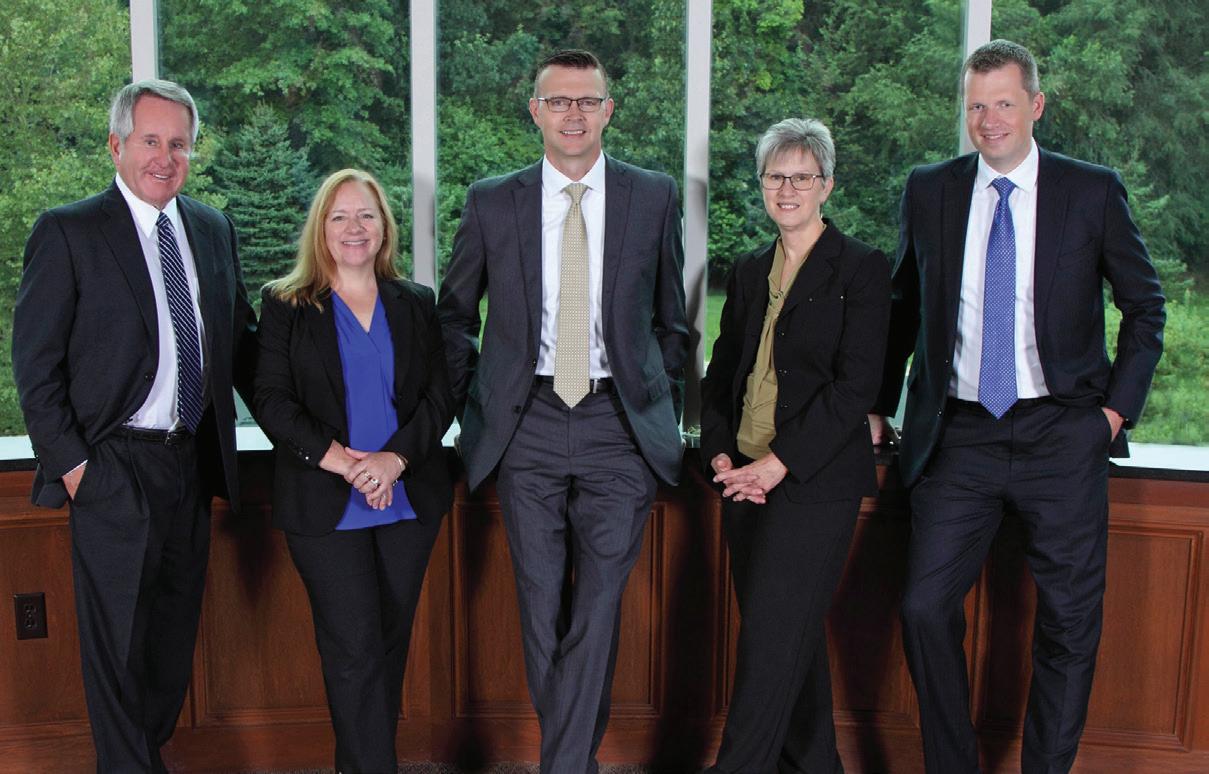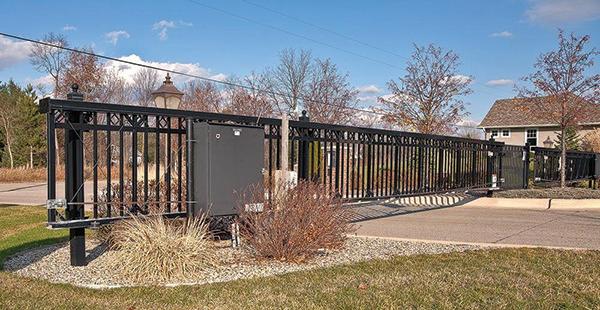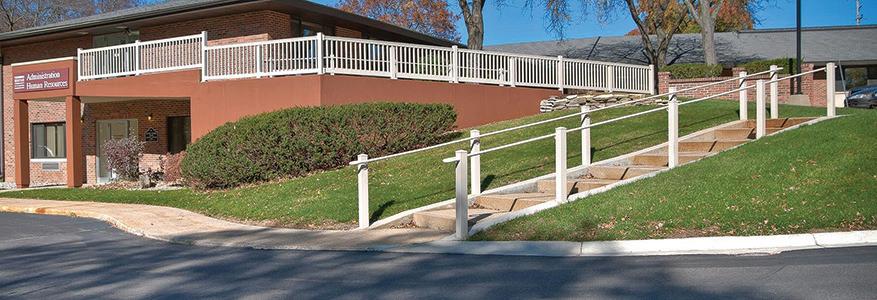
17 minute read
FEATURE
Ian Gorman at the mixing board in the recording engineer's booth of La Luna Recording and Sound.
There's a bit of a time warp happening in a corner of the Edison neighborhood.
A cluster of old brick buildings on Fulford Street stands as a Rust Belt relic. The buildings used to house the 1898 Star Brass Works foundry, which made parts for trolley machinery and tone rings for Gibson banjos in the first half of the 20th century.
At the southern end of the buildings is a 1940s expansion, a windowless, drab hulk built to manufacture munitions for World War II. Open an old wooden door to that building and you enter La Luna Recording and Sound, and it could easily be the golden age of recording studios and producers making recorded music that rocked the world, from the 1960s-1980s.
Go past the small sound booths where individual musicians and vocalists do their thing, across a room big enough for a small orchestra, past the large, working 1940 RCA radio and the 1920s Victrola in the restroom across from it and into the recording engineer's booth, and you’re back in 2020: Mac computers run Pro Tools audio software, and La Luna's founder and head engineer, Ian Gorman, sits at the mixing board, wearing a Covid-era mask.
The studio décor and vibe, "a combination of modern and vintage,” are the result of Gorman’s careful crafting. The studio feels timeless, literally. Inside La Luna, one can't be sure if it's day or night. A variety of old lamps and strings of white Christmas lights provide the only light. "It's like Vegas," Gorman says. "No windows, no clocks." With no distractions, artists and engineers can lose themselves in their work.
Here such nationally recognized artists as comedian and musician Stephen Lynch and the band Greensky Bluegrass — as well as dozens of artists from across the state, including the Kalamazoo-based bands The Go Rounds and Last Gasp Collective — have recorded their work. And while the studio’s vibe is nice, it is Gorman that they come for. ‘Sonic mad scientist’
Lynch, a Kalamazoo resident, recorded his 2019 nationally successful comedicsongs album, My Old Heart, under Gorman's
guidance. "Ian’s great,” Lynch says. “He’s like a sonic mad scientist. He hears frequencies that normal human ears don’t."
The Go Rounds have produced six albums with Gorman, and they gush on their Facebook page that he "may just be the best engineer in the state if not the country.”
“So much care goes into every decision,” they say. “He says, 'If you're not happy, I'm not happy.'"
Sincerely modest and not looking to be the star of the show, Gorman is quick to point out that La Luna is more than just him — he has a stable of mostly twentysomethings working as producers, engineers and assistant engineers.
Squeeze him for more info and he admits that La Luna is approaching its 500th project. And he estimates that in his career, going back to his student days, he's worked on close to 1,000 projects. Raised among records and art
"I think it was inevitable I'd get into the artistic life in some way," Gorman says.
Gorman was born in 1977 in a house full of records and art. His father, Jim Gorman, was a disc jockey at the Detroit progressive rock station W4. His mother, Marilyn Gorman, was an artist who met his dad in 1971 on a job drawing caricatures of on-air radio personalities.
Ian grew up "in the house of a working artist who wasn't just drawing for fun on a Sunday afternoon but who was working jobs, had consignments and clients and who had to be disciplined and take it seriously and have a great time doing it too."
But it was the records that put Gorman on his current path. As a kid, he'd dig through his parents' classic LPs, listening to everything from the Beatles and the Rolling Stones to folk albums from the Holy Modal Rounders and FCC-not-approved comedy by George Carlin. Gorman also delved deeper into the past — Benny Goodman, Robert Johnson — and then got into alternative and underground sounds as a teen.
He became a musician himself, playing rock, folk and roots music at open mics and, as a Western Michigan University student, with bands in Kalamazoo. He now plays most types of stringed instruments for the roots/ world band The Red Sea Pedestrians along with his wife, Rachel Gorman.
Gorman admits, "I didn't know what I wanted to do” as a WMU student. “I wanted to play music, but I didn't know what that meant yet." Wanting to learn about making records from a musician's viewpoint, he took a class taught by WMU recording instructor John Campos. Campos teaches the basics like
Clockwise from top left: An antique organ adorns one wall of La Luna’s main studio; Gorman, at left, and Jacob Wolfe, an assistant engineer and intern, listen and watch the monitors as an artist records in the studio; and instruments stand at the ready in the main studio.


microphone placement and track mixing, "but one of the things that he does that is so remarkable,” Gorman says, “is that he teaches you all the other stuff too ... about how to be in a room with other people and be an artistic ally to them, the real-world skills. "He changed my life," Gorman adds. "Soon I was obsessed with being in the studio, and a lot of it was because of him and his influence."
Gorman found himself literally at home in WMU's Western Sound Studios. "As soon as John gave me keys to the place, it was over. I was sleeping on the couch." Kalamazoo to Chicago and back
After graduating from WMU, Gorman went to work for the Chicago Recording Co., where he participated in sessions for rock bands like Smashing Pumpkins and Wilco and captured sounds from easy-listening's Mannheim Steamroller to rap's Twista. "I learned a lot," he says, but working 20hour days and facing "massive celebrity egos and hardened entertainment industry cycles
Dropping Names
Among the Michigan artists who have worked with La Luna Recording and Sound are:

• Lushh/Eddie
Codrington • Stephen Lynch • Joel Mabus • Mark Nepo • Red Tail Ring • Jen Sygit
• Seth Bernard • Breathe Owl Breathe • The Crane Wives • Dominic Davis (Jack White's band) • Rachael Davis • Megan Dooley • Earth Radio • May Erlwine • The Go Rounds • Greensky Bluegrass • Jordan Hamilton • Last Gasp Collective of abuse” took its toll. "It probably took 10 years off my life from sleep deprivation and stress, and I decided it wasn't the life for me."
Lured by the “super supportive” independent Michigan music scene, Gorman returned to Kalamazoo. “There's no competitiveness,” he says. “It's communityminded. There's this back and forth. There's this influence, this collaboration. Everybody's playing with each other."
In late 2001 he opened La Luna in his garage. The business grew, and the need to expand, combined with the fear that his neighbors might not appreciate "someone playing tuba poorly for eight hours," brought Gorman out of his garage. In 2018, La Luna moved into Jericho Town, a complex of refurbished industrial buildings on the eastern edge of the Edison neighborhood that also houses a piano shop, a guitar manufacturer and the café/scooter shop Fido Motors. "This was just a big, empty space," Gorman says, motioning around the La Luna studio. "Concrete floor, leaky roof. We basically built a house inside of it." There was no sewage system and no electricity. Gorman credits Jeb Gast, Jericho Town’s owner, for helping to make the space fit for making records.
When Gorman talks of recording, he still says "making records." While some La Luna recordings go on vinyl and others become
Spring is the perfect time to organize and refresh your home. Welcome Spring! Whether it’s a pantry redo or custom closet, our storage solutions make staying organized a breeze.

Contact Bette Today

Contact Bette Today

hallsclosets.com 269.382.5182
AUTHORIZED DEALER AUTHORIZED DEALER
purely digital and online, they are all still "records" to Gorman. "There's still this art and beauty to making records," he says. "(It can be) capturing a raw moment in time ... or it's fine-toothed-comb creating something out of nothing that has no ties to the real world, that exists in the sonic realm. I love it so much." Facilitator, therapist
On an autumn evening, singer and multiinstrumentalist Dylan Tolbert is pouring his heart out in one of La Luna’s small sound booths, working on his song "Superheroes and Laser Beams." He is visible through the control booth window above the mixing board and across the expanse of the main studio floor, and his singing — deep voice, impassioned soul with a Stevie Wonder influence — is coming over the audio monitors perfectly. It's like Tolbert is in a little space capsule, and Gorman is heading Mission Control.
Assistant engineer/intern Jacob Wolfe sits behind Gorman, watching and listening intently. Gorman rarely touches the mixing board — the faders are set just right — as he watches the tracks and waveforms on the computer monitors, his head bobbing to the music while he takes notes on paper. The only interruption in the room’s intensity is when Gorman compulsively sticks a pencil into a whirring electric sharpener near the booth's lava lamp and Bigfoot statue.
Tolbert arrived at the session worried about his voice. That weekend at a wedding he'd done some singing and maybe had a little too much fun. He sounds perfect, but he wants another take. Gorman is supportive of every suggestion, bobbing his head along with every take and every playback, even though he's heard various versions of Tolbert's songs repeatedly.
They switch to Tolbert's "Little Too Much." Tolbert sings along to a prerecorded track of himself playing guitar. There's something in the mix, a subliminal deepness in the vocals. Does Tolbert's voice have unearthly powers? Or is the sound created by fancy computer effects?
Gorman and Tolbert explain that there’s a ghost of a vocal on the guitar track because they're using Tolbert's first guitar take, when

Above: The team creating musical magic at La Luna is, front row, left to right, Maggie Heeren, Ian Gorman, and Cynthea Kelley; back row, left to right, Tony Mitchell, Paul Schaedig, Claire Horn, Samuel Peters, Julián Guerrero and Jacob Wolfe. Right: La Luna is housed in a former factory in the Edison neighborhood.

he was singing along while playing. They were going to do a clean guitar take, without the ghost vocal, "but I've really come to like it," Tolbert says. Gorman deems it “a happy accident."
Then they go over seemingly endless variations of "Superheroes" — with the guitar track, without, with guitar on the intro or muted or silent on the first chorus. It's methodical work, requiring an effort to hear, with fresh ears, portions of the same song over and over.
Gorman sees himself as a facilitator of this process, but he's also somewhat of a therapist, patient with artists trying to capture their life's work, their deeply felt lightning in a bottle. Gorman says a recording engineer's attitude is more important than his 24-track deck or his Pro Tools. "Most importantly, you've got to be the right vibe and the right spirit in the room," he says. "It's like playing in a band with someone. You have to get to know them, get to know what helps them be better and try to communicate with them. "My job is not to make the musician do what sounds good to me. To me that's bad engineering or producing, the ‘I know better than you’ sort of attitude. My job is to always help the musician get what they want, and that's something that I really love doing. Sometimes involved in that is giving them a different opinion, like, 'Hey, that thing you're trying to do, maybe there's another way to do that and be more-effective.' Sometimes it involves guidance. Sometimes it involves not guiding anything and letting them drive the car.”
La Luna works mostly with Michigan artists, and Gorman has a long list of those whom he's loved working with. One of his biggest records was Lynch’s My Old Heart, which debuted at No. 1 on Billboard's comedy charts and was one of Gorman's last projects before he moved La Luna from his garage. "To say that we did that in my garage felt pretty good," he says.
Lynch says of Gorman, "I could ask him for something in a super non-technical way like, 'Can you make that piano sound more angry?' and he’d know exactly what I meant. And he’d make it happen. I love the way My Old Heart turned out, and I’ve already begun laying down tracks for my new record at La Luna."
Lynch is "one of my favorite songwriters," Gorman says, because he takes musical production of a song very seriously, and "then you put the vocal on there and laugh your ass off."
Other Gorman favorites include roots/folk artists Greensky Bluegrass, Seth Bernard and May Erlewine; Kalamazoo's soul/hiphop/ eclectic Last Gasp Collective and their producer, Jay Jackson; New York Times bestselling poet/philosopher Mark Nepo; and Dominic Davis, who's now in Jack White's band.
A lot of records Gorman has engineered have had national success as independent productions, without the backing of major-label money. "Almost everybody I work with are independent artists. I'm very proud of that," he says. "I love the empowerment of an artist being in control of their own creative vision and not having it affected by either outside label influence or just simply the pressures of fame, which is a really difficult thing for an artist. I wish they all had labels to help with their bills and get them more money, get their stuff heard by more people,

A wealth management firm that believes in commitment … to its employees, its clients, and its community.
We built it.

Ray Financial Group
Kent Ray
Senior Vice President/Investments
Jeff T. Siefert, CFP®
Vice President/Investments Greg Seiler, CFP®
Vice President/Investments
Rena Fields
Registered Client Service Associate Sue Brenner
Registered Client Service Associate
950 Trade Centre Way, Suite 305 Portage, Michigan 49002



Fence, gate and railing services since 1981
Kalamazoo, MI • 269.381.0596 • www.fngfenceandgarden.com



All pools built locally by Vlietstra Bros.
Built for a lifetime of relaxation…


4266 Ravine Rd. Kalamazoo, MI 49006 www.vlietstrabros.com 269-349-7779
Winter Hours: Monday - Friday 9am - 4pm
but I love the creative freedom that all these people have." Recording these days
But music is a difficult business, even without the impact of a pandemic. "Like most people I know in the music world, we do it because we have to — it's just something inside of ourselves that's just obsessed with it," Gorman says. “Nobody picks the music business because it's a safe and lucrative job choice, especially in 2020.”
Gorman says that the music industry “is just a shadow of what it was just a couple decades ago,” when bands put out albums and toured to promote and generate sales of those albums. The digital availability of music and music streaming services have changed that.
“Nowadays bands aren't selling music. What they do sell is a tiny, tiny fraction of what it was, and nobody's making a living just selling albums anymore," Gorman says.
Artists now earn a living by playing live for paying audiences, which became nearly impossible as of mid-March 2020. Since the pandemic hit, things have been "brutal" for musicians, he says. "It's really dark times for a lot of musicians career-wise,” Gorman says. “I know people who were paying their bills playing music, but now they have to get other jobs."
At first Gorman feared that the pandemic would also mean, "Goodbye, recording studio!" But "people are still really hungry to create," he says. As a result, there's been a greater demand for the professional ears at La Luna. Webstreams, online videos, even non-music content like video-game audio or audiobooks all need professional sound. "Surprisingly, we're as busy or busier than we've ever been, and I was not expecting that," Gorman says. "So many people I know have been funneling their creative energies into recording or streaming, that kind of thing."
Tony Mitchell, an assistant engineer at La Luna, says with a laugh, "I now mix webinars. Five years ago, if someone said, 'You're going to mix webinars one day. You're gonna love it, trust me! ...'" He breaks up laughing, without finishing his thought.


And despite the fact that there is technology to replace them, engineers "will always be relevant," says Samuel Peters, an engineer/producer.
With technology, “a robot analyzes the waveform, and then a robotic arm comes and turns all the knobs of analog gear. You're still getting an analog sound, but it's by a robot," Peters explains. But human ears, with all their imperfections, are still a better instrument for the job. "I would trust a person before trusting a robot," Peters says.
Human engineers are also better at working with human artists, Mitchell says. "I think communication is a large part of what we do too."
There's stress in the process, Peters says, as seen in sessions where "by hour nine the band is exhausted,” where the vocalist does, "like, a hundred vocal takes. He's seeking perfection because he is paying for the time, the space. It's the engineer's job to help navigate them through that frustration in a productive way."
Mitchell adds, "You're holding that weight and trying to make it not seem so daunting, so overpowering, because it can quickly turn into being too much. Seeing Ian work with people, he's really good at talking people down, showing all the different options they have at the table."
Whether he knows he is inspiring to others or not, Gorman is just happy to stay in the background behind his mixing board and screens, giving reassuring words to artists asking for another take. It's all about helping an artist "really grab onto the process and make it their own," he says.
That philosophy is obvious when he talks about local singer Amy Love, who's been recording her first album at La Luna. "(She’s) a really fantastic artist. It’s great seeing someone who's relatively new to the process and to take to it and understand it and become empowered by the options in a positive way,” he says. “She’s like, 'Hey, I've got this sound in my head ... .'"
And Gorman's response is, "We can get that!" And he does.


Evaluation & Care of Trees and Shrubs
Kalamazoo, MI • 269-381-5412 • www.arboristserviceskzoo.com
YOU CREATE. WE FUND.
ACGK membership has its benefits!
ACGK administers 6 grant programs for which individual artists, arts organizations and non-profits can apply.
Did you know that it’s FREE for
Arts Council of Greater Kalamazoo members to apply for grants? Last year alone, we gave out over $335,000 to 80 individual Artists and Arts Organizations for grant projects, professional development, educational arts supplies and transportation, and COVID relief.
How can we help you?


